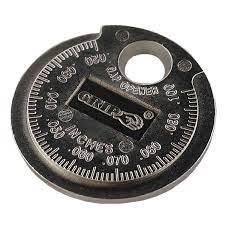Spark plugs are essential components of a car’s ignition system because they ignite the air-fuel combination in the engine cylinders, thereby starting the combustion process. This controlled explosion produces enough power to propel the vehicle. Spark plugs can wear out over time, resulting in inefficient combustion and lower engine efficiency. Regular maintenance, such as changing spark plugs at specified intervals, maintains a steady and optimal spark, resulting in efficient fuel combustion. This improves not only engine power but also fuel efficiency, contributing to overall vehicle performance and lifetime. The most frequent symptoms of faulty spark plugs include start-up issues, rough idling, sluggish acceleration, declining fuel economy, engine misfiring, and engine knocking.
Step 1: Gather Necessary Car Tools:
Before changing spark plugs, you need the right tools to maximize your success. You can get them here
- Socket wrench

- Spark plug socket

- Spark plug gap tool

- New spark plugs.

What happens if the wrong spark plug is used?
It is crucial to use the right spark plug type and spark plug gap for your specific vehicle to ensure proper combustion, prevent engine misfires, and maintain optimal fuel efficiency, as each vehicle has unique requirements for ignition system components. If it becomes too hot, it will burn a hole in the piston. Too cold, and the chamber becomes clogged with unburned gases. If it is too lengthy, it will break a hole in the piston; if it is too short, it will have the same problem as one that is too cold.
Step 2: Locate the Spark Plugs:
Spark plugs are found in the engine bay at the top of the cylinder head identified by a series of wire connectors running to the engine cylinders. Depending on the car’s make and model, consulting the vehicle’s manual or other resources can provide particular assistance on the exact location.
Step 3: Prepare the Vehicle:
Before starting the spark plug replacement, ensure the vehicle is in a secure and stable position, such as on a level surface or supported by jack stands. To prevent electrical accidents and assure safety throughout the procedure, disconnect the negative terminal of the car battery. Allow the engine to totally cool before attempting to replace the spark plugs to avoid burns and injury.
Step 4: Remove the Old Spark Plugs:
To remove the old spark plugs, carefully detach the spark plug wires from each plug by twisting them gently while pulling. Next, loosen and remove each spark plug by rotating anticlockwise using a spark plug socket attached to a socket wrench. To avoid stripping, make sure the socket is properly positioned on the spark plug and work slowly to avoid harming the threads in the cylinder head.
Step 5: Inspect the Old Spark Plugs:
Look for signs of spark plug wear, such as corroded electrodes, and check the color of the spark plug’s insulator for signs regarding the engine’s combustion conditions during inspection. Fouling (carbon deposits) on spark plugs can indicate rich fuel mixes and worn-out electrodes might signal potential ignition system concerns that need to be addressed.
Step 6: Gap the New Spark Plugs:
The appropriate gapping of new spark plugs is critical for maximum engine performance since an incorrect gap can result in misfires and decreased efficiency. Using a spark plug gap tool, insert the tool’s wire loop between the center and ground electrodes and adjust the gap until it meets the suggested standard specified by the car’s manual or the package of the new spark plugs.
Step 7: Install the New Spark Plugs:
Thread a new spark plug into the cavity where the old one was removed, taking care not to cross-thread or force the plugin. Screw it in until it’s finger-tight, then give it another half-turn with your socket. Rub a little anti-seize lubricant on the threads of most spark plug brands to ensure that the spark plugs are easy to remove the following time.
Step 8: Reconnect the Battery and Test:
After removing the spark plugs, reconnect the battery by connecting the positive terminal first, followed by the negative terminal, ensuring a strong connection. Start the car and listen for unusual engine sounds or check for dashboard warning lights; if problems develop, double-check the spark plug installation, inspect wire connections, and check the vehicle’s manual for additional troubleshooting advice.
Conclusion:
Changing spark plugs regularly is critical for maintaining optimal engine performance, improving fuel efficiency, and avoiding potential problems such as engine misfires and lower power. This detailed guide walks you through the procedure step by step, emphasizing the significance of good maintenance to guarantee a smooth-running car and improve its overall longevity.



